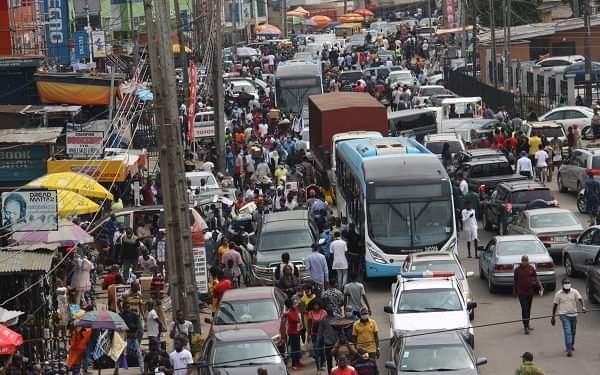
Lockdown relaxation kicked off Monday in Lagos, Ogun and the Federal Capital Territory (FCT) amidst stern warning for residents to obey new measures to keep them safe. ROBERT EGBE looks at the history of how pandemics resurged following lockdown violations around the world
The man and woman who became literary critic Ikhide Ikheloa’s parents, Mr O. Ikheloa and Miss C.I. Omosun, were in love.
But they were separated by a great distance – he in Benin, she on Lagos Island.
Courtship must have been cumbersome, so, they found another way: letters.
On August 27, 1957, Omosun sent hers by Air Mail from her 9, Pike Street residence to Ewu Catholic School, via Ubiaja, where Mr O. Ikheloa received his mails.
As Ikheloa revealed in an April 6 post on his Twitter handle, the letter didn’t just tell part of his parents’ love story, two years before he was born, it also chronicled a global health crisis that ravaged Nigeria 63 years ago: An Influenza pandemic,
“…It affected Nigeria greatly. My mother wrote about it in a love letter to my father,” Ikheloa, affectionately known as ‘Pa Ikhide’ on social media, tweeted.
New disease, old problem
The contents of the then Miss Omosun’s letter paints a grim picture of a health menace similar to what is, once again, the world’s new reality: Schools, businesses, religious centres shut, air, rail and sea travel suspended, movement restricted and everyone cowering indoors following the outbreak of the highly infectious coronavirus COVID-19 pandemic.
But even before the influenza pandemic of 1957, there was another one in 1918 touted as one of the most deadly in world history. It was caused by an H1N1 virus with a gene of avian origin. It spread worldwide between 1918 and 1919 and killed at least 50 million.
According to the Public Record Office London, the influenza hit Lagos on September 14, 1918, four years after the Amalgamation of the Northern and Southern Protectorates by Lord Fredrick Lugard.
Lagos lost 1.5 per cent of its 81,941 population in the first two months.
Inhabitants around the seaports of Marina and Apapa, especially seamen working on ships docked on harbour ports were one of the first sets of people to be infected with this virus and it spread to the hinterland and most Lagos Island inhabitants.
Just like the current government is doing with COVID-19, the colonial government swung into action by creating different means of spreading information, educating people on how to best stay healthy during that period. House to house disinfection was also done.
Still, people from Lagos fled the infested town to other parts of the country. The virus spread to Abeokuta, Ibadan, Illorin, Bida, Jebba, Zaria, Kano, and Bauchi by train.
On October 14, 1918, the flu was detected in Onitsha, where a large number of people got infected and died.
By December 1918, it had spread all over the country. By mid-1919 the pandemic came to an end, as those who had been infected either died or developed immunity against the virus.
COVID-19: Dangerous new kid on the block
212 countries and territories around the world and two international conveyances had been affected by the virus as at 8:30am on Sunday morning. There were 3,485,936 COVID-19 cases around the world, 244,803 were fatalities while 1,124,470 persons had recovered.
In Nigeria, there were 2,388 confirmed cases, 85 deaths and 385 recoveries since February 27, when the country’s index case, an Italian, was confirmed. But only 1,918 cases were still active.
Last Thursday, Minister of Health Osagie Ehanire said about 113 health workers in the country had tested positive for COVID-19 and had had to enter quarantine and seek treatment.
Lockdown relaxation
President Muhammadu Buhari declared a two-week lockdown of Lagos and Ogun states as well as the Federal Capital Territory (FCT) Abuja during his first address on the pandemic on March 29, 2020, to enable the country check the spread.
He addressed the nation again on April 12 and extended the lockdown by two weeks. But on April 27, he approved a ‘phased and gradual easing’ of lockdown measures in Abuja, Lagos and Ogun when he extended the lockdown by one week.
Beginning on Monday, a dusk-to-dawn curfew would remain and anyone out during the day will be required to don a face mask, among other measures.
Organisations like the Nigerian Medical Association (NMA) on Sunday warned that the lockdown may have been lifted too soon.
But there is no global consensus on how lockdowns should be lifted.
Last Monday, the World Health Organisation (WHO) touted the benefits of COVID-19 restrictions.
Chief Executive Director of the WHO Health Emergencies Programme Michael J. Ryan said lockdowns helped suppress the spread of the disease by preventing its ability to find new victims.
But he also added that in lifting lockdowns, localities must look closely at their populations, considering how to protect their most vulnerable, and make decisions based on their specific context, said Ryan.
“We don’t know for sure which are the measures that will result in a successful exit strategy.”
What people going out must do
To protect people, the federal and state governments put in place several measures. They include: mandatory use of non-medical face mask/covering for all persons while in public spaces. Latex hand gloves should not be worn except for specific medical purposes;
Mandatory provision of hand washing facilities/sanitisers in all public places, all interstate travel is prohibited except for essential travels & services, such as: transportation of agricultural products, petroleum products, relief items, goods, commodities related to the COVID-19 response and persons on essential duty.
Mass gathering of more than 20 people outside of a workplace is also prohibited. There will also be controlled access to markets and locations of economic activities.
Mandatory temperature checks will be conducted in public spaces, social distancing of 2 metres must be maintained between people in workplaces and other public spaces. The ban on all passenger flights and religious gatherings are still in effect.
How pandemics resurged after lockdown measures were violated or relaxed
Failure to keep to the government’s lockdown measures can be disastrous. History is replete with examples that Nigerians must simply learn from, otherwise they risk bringing disaster on themselves and others.
Already, lockdown violators are responsible for cases of the virus in nearly all parts of the country except Lagos, Ogun, Abuja and Benue.
Examples of pandemics worsened by inadvertent violations include: the Great plague of Marseille and the San Francisco flu of 1918 among others.
Great plague of Marseille
The Great Plague of Marseille was the last major outbreak of bubonic plague in Western Europe. Arriving in Marseille, France in 1720, the disease killed a total of 100,000 people: 50,000 in the city during the next two years and another 50,000 to the north in surrounding provinces and towns.
In 1720, a ship was quarantined at the port in Marseille because a strange infection was killing people on the ship.
The ship had left Sidon in Lebanon, picked up people at Tripoli, and Cyprus which already had infection outbreak before reaching Marseille.
But Deputy Mayor of Marseille lifted the quarantine to “help the economy”, and the plague ended up killing more than half of the city.
The government of Marseille felt the city could not afford to lose all the valuable goods on the ship as it would destroy the economy,
Some powerful businessmen led by the deputy mayor of Marseille (who was also the owner of the ship) convinced his friends in government to lift the quarantine. Some merchants needed the cotton and silk cargo on the ship to do business for the upcoming festival in Beaucaire.
The government was persuaded. But as it lifted the quarantine and moved the goods into the city of Marseille, they unknowingly moved in infected rats which then infected people.
Days later, the infection broke out in the whole of Marseille. People began dropping dead, until there were no more graves to bury them. Dead bodies littered the streets.
The French government built a wall to stop Marseille from infecting the rest of the country.
But it was late. 10,000 people from Marseille had already escaped into neighbouring cities and 50,000 people died outside of Marseille.
Spanish flu in San Francisco (1918)
Some 50 to 100 million people died in the 1918 influenza pandemic – numbers that surpass the death toll of World War One, which was being fought at the same time. The 1918 flu virus infected one in every three people on the planet.
But its effect on the U.S. city of San Francisco is worthy of mention. San Francisco had the 1918 flu under control, until it lifted the restrictions.
A local man who had returned to his home after a recent trip to Chicago brought the disease to the city.
Officials soon ordered everyone to wear face masks and banned public gatherings amid soaring Spanish Flu infections. The restrictions worked and the numbers of cases and fatalities fell within weeks.
By the end of October, San Francisco had experienced nearly 20,000 cases of influenza and over 1,000 deaths. Still, the situation had improved enough for the Board of Health to lift the various bans on November 16. Due to the high numbers of cases still being experienced in some areas, theatres there were kept closed for an additional week.
All across the city masks had to be worn by every patron of every theatre, and the order to wear masks had to be shown on screen before each performance. Hotels and restaurants could resume their musical entertainment, but no dancing was allowed. Schools did not re-open until November 25. In a double blow to children, the holiday break was shortened and the school day extended by 20 minutes in elementary schools and 45 minutes in high schools.
But after having been starved of most entertainment outlets for a month, San Franciscans packed the city’s theatres, movie houses, and sports arenas.
At noon on November 21, San Franciscans simultaneously removed their masks as a whistle-blow sounded across the city, the result of Mayor Rolph’s annulment of the ordinance the previous day.
But the flu rebounded some three weeks after that and led to a longer outbreak than the first one. The epidemic brought nearly 45,000 cases of influenza to San Francisco and killed over 3,000 of its residents in the fall of 1918 and the winter of 1919.
Dr. Oguntola Sapara
During plagues and disease outbreaks in pre-colonial Nigeria, people sought native medicine and other unorthodox means to cure these illnesses. Some worked while others worsened the situation. An example is the riddle of the smallpox epidemic in Epe in 1897, which was solved by the brilliant unorthodox approach by Dr. Oguntola Sapara Williams.
Epe, a town off the coast of Lagos, was hit by a smallpox epidemic in 1897.
The magnitude of the epidemic was severe and the death toll was more than the community had ever recorded from any disease.
Dr. Sapara, the first native appointed assistant surgeon, was posted to Epe to help. While there, Sapara suspected that local smallpox cult was responsible for worsening the health crisis,
The smallpox cult worshipped Sopona (the Yorùbá god of Smallpox) and the doctor joined it with the secret motive of understanding their operations and eventually terminating their activities.
Sapara found that the cult members who would take scrapings from skin rashes of actual smallpox cases and apply on the skin of uninfected persons, leading to more infections.
“In 1897 when I took charge of Epe district, the town of Epe was known as the hotbed of the small-pox epidemic. Finding that vaccination and other precautions seemed to fail, I joined the cult and having got into the mysteries, I summoned the small-pox priests together and threatened them with prosecution for disseminating the disease and used perchloride (sic) of mercury solutions. They left the town through disgust and since then, up till the time I left Epe, vaccination had scope for doing good work and then the town enjoyed immunity from smallpox, hitherto unknown”
One major aftermath of this situation was that the colonial government enacted the Witchcraft and Juju Ordinance in 1917 and made the worship of Sopona (the Yorùbá god of Smallpox) a crime punishable by fine and imprisonment.
What research shows
Massachusetts Institute of Technology (MIT) researchers recently developed a new model of studying the spread of COVID-19 infections.
Applying publicly available data to machine learning, the researchers modelled what relaxing global lockdown rules could do to COVID-19 cases.
The model indicated that any immediate or near-term relaxation or reversal of quarantine measures currently in place would lead to an “exponential explosion” in the number of infections.
The report ‘Quantifying the effect of quarantine control in Covid-19 infectious spread using machine learning’ was published in early April.
Empirical evidence from several countries support the WHO warning and MIT research.
Swedish paper The Local reported on April 27 that during the week before Easter, Sweden recorded its highest number of deaths in the 21st century after controversially resisting Coronavirus lockdown measures.
2,505 people died in the week of April 6th-12th, equivalent to 358 deaths each day. The weekly figure was almost 150 more deaths than in Sweden’s second deadliest week of the century, which saw 2,364 people die during the first week of the year 2000.
On April 30, the Ghana Health Service reported 403 new cases in the country 10 days after President Nana Akufo-Addo eased a three-week lockdown in Accra and the city of Kumasi. The figure was a 24 percent increase.
On April 29, Eastern European nation Bosnia also reported its sharpest daily rise in new coronavirus infections last month after its two autonomous regions gradually eased lockdowns.












